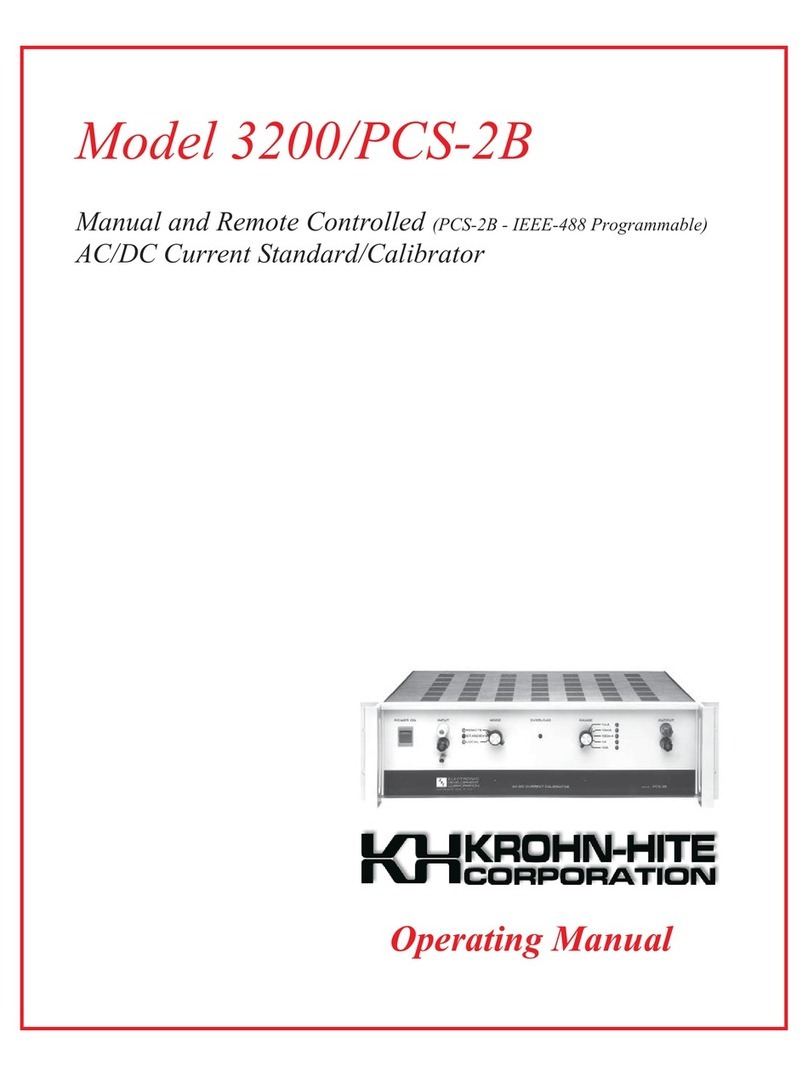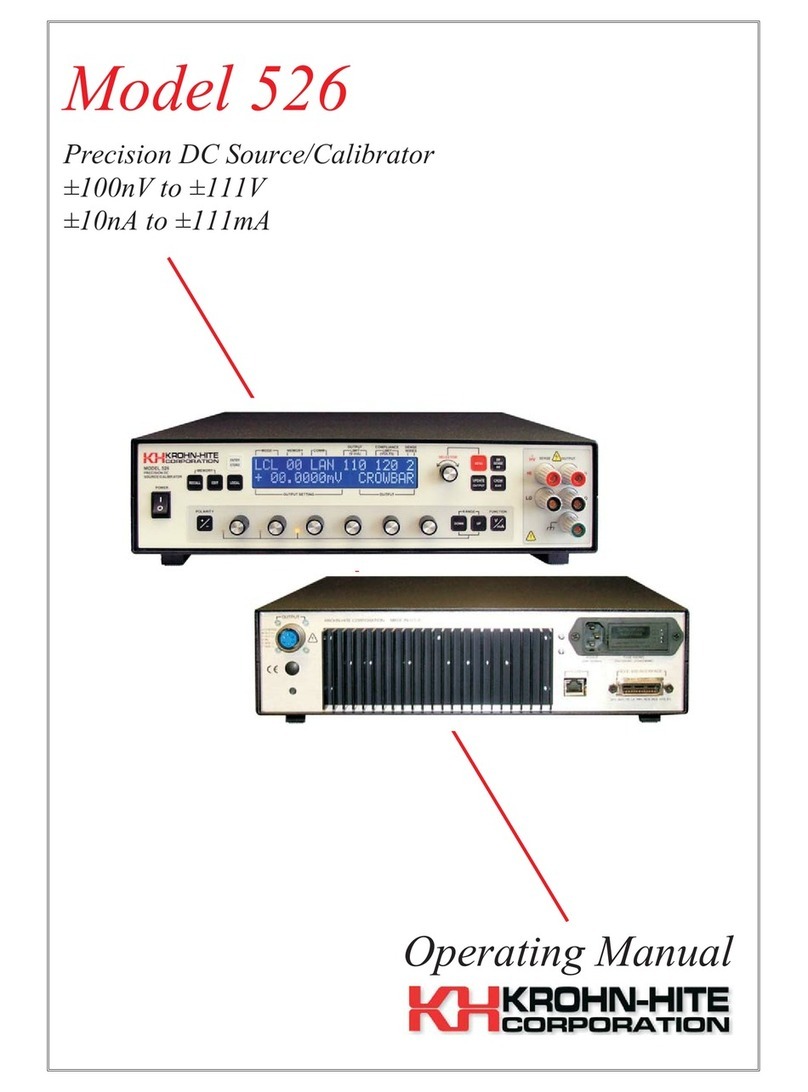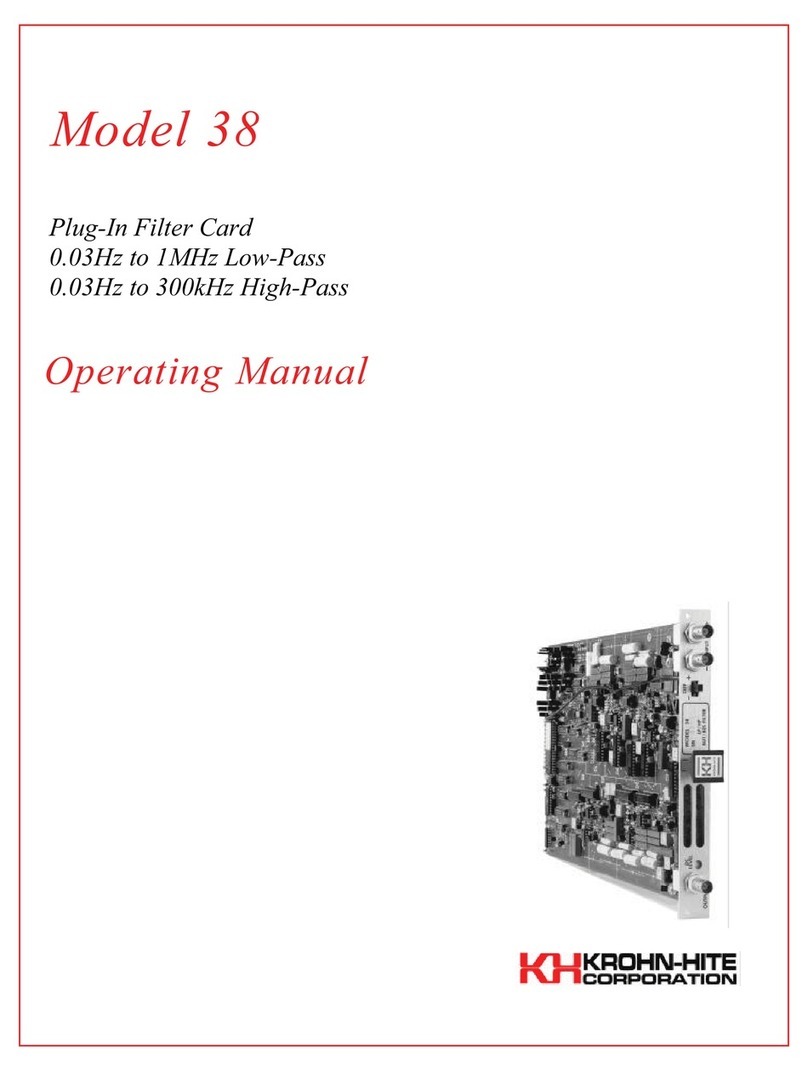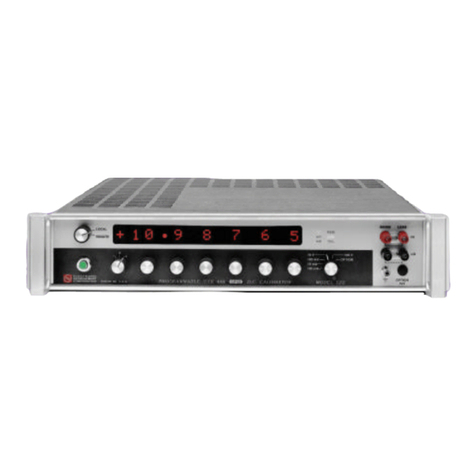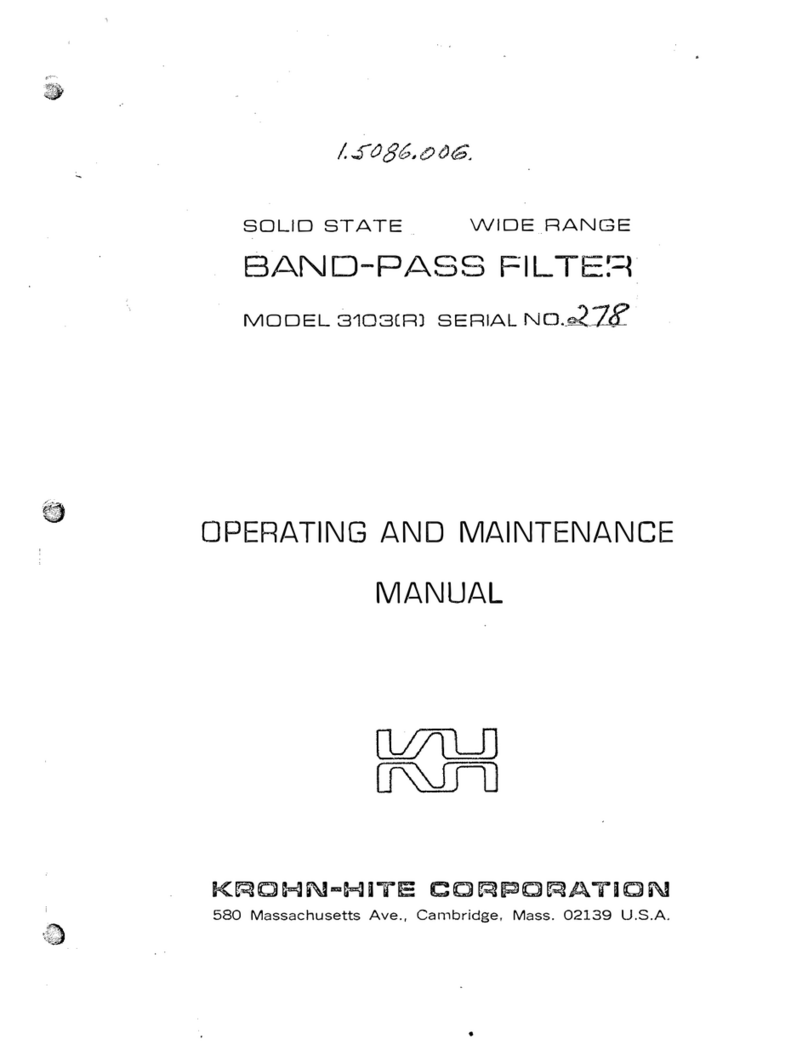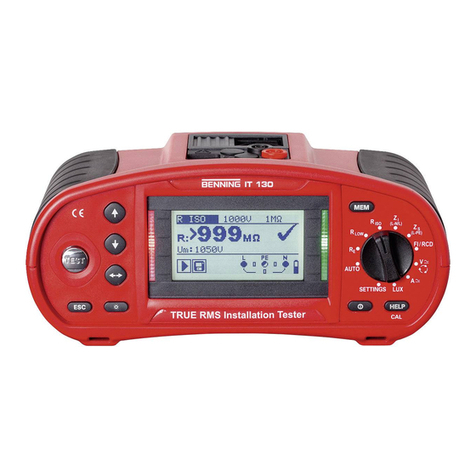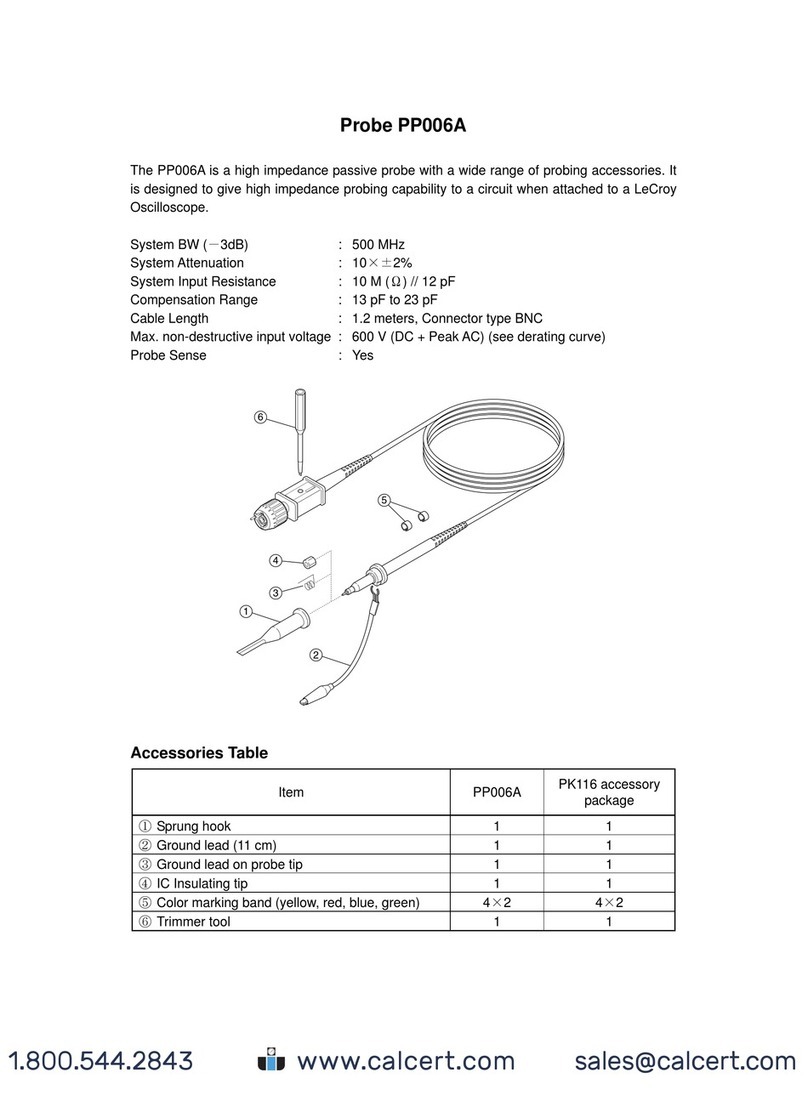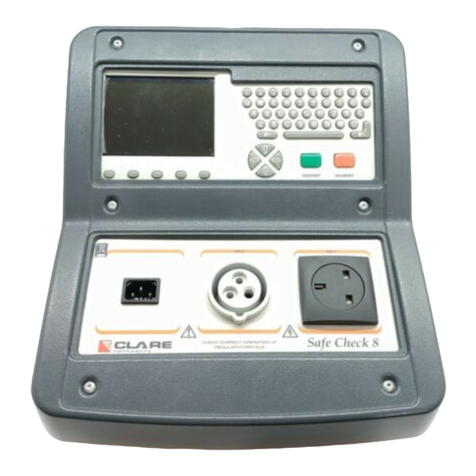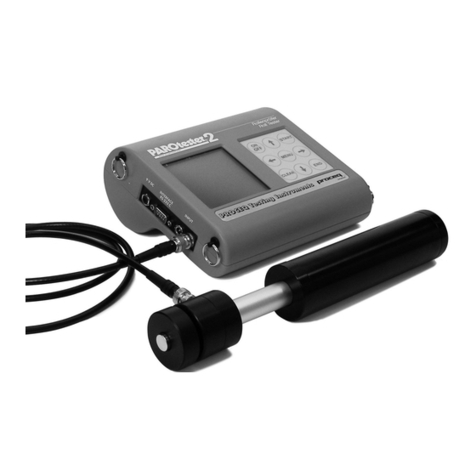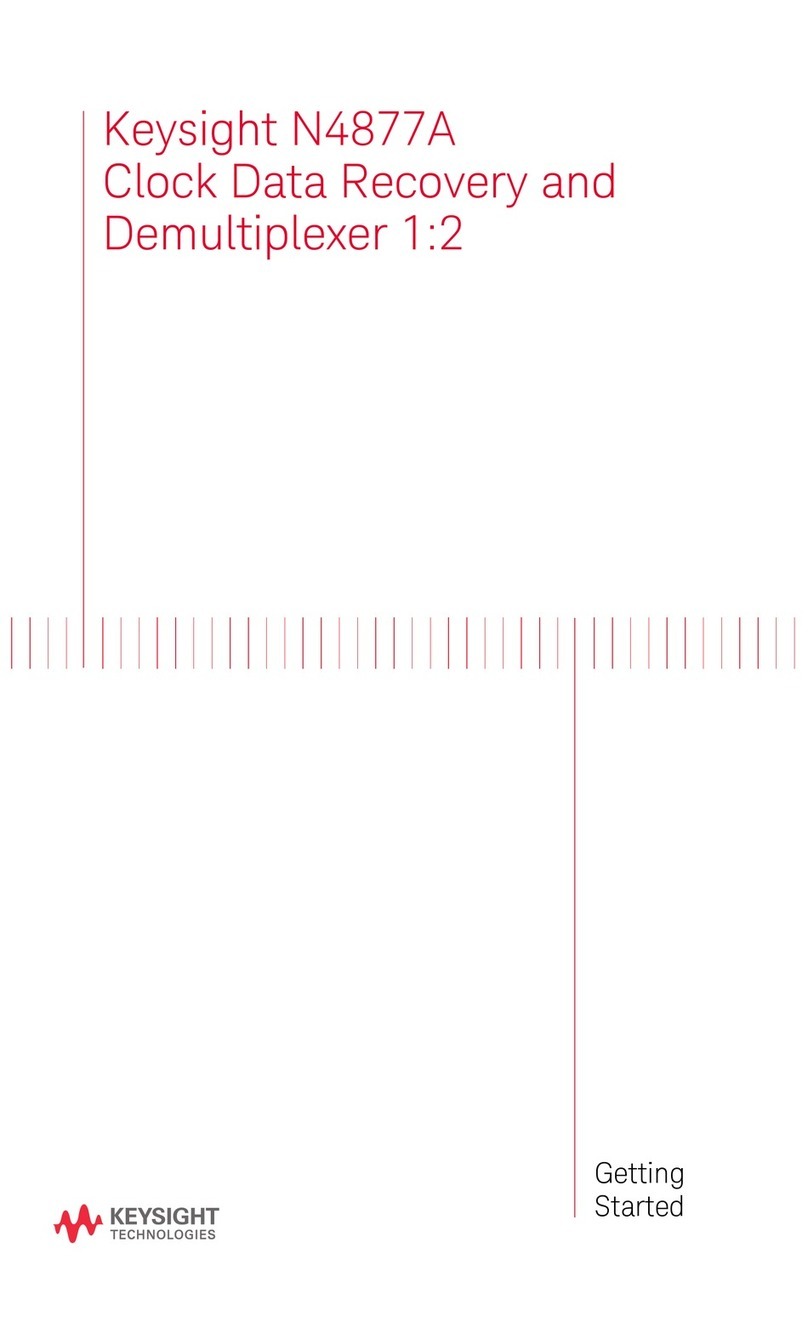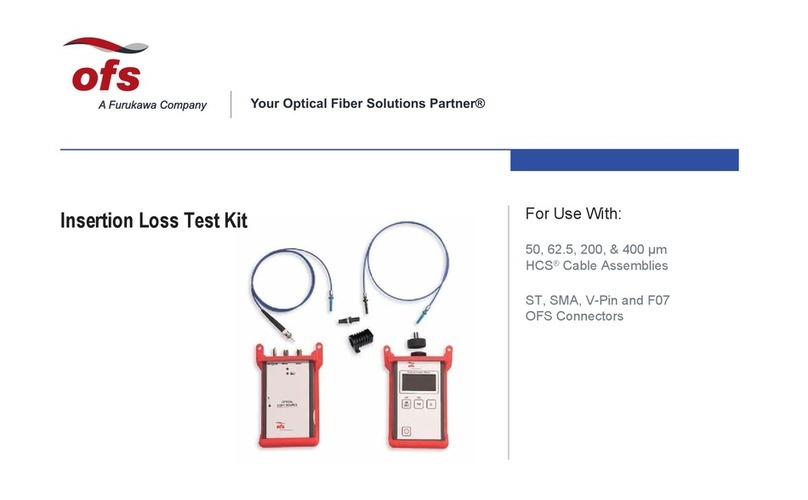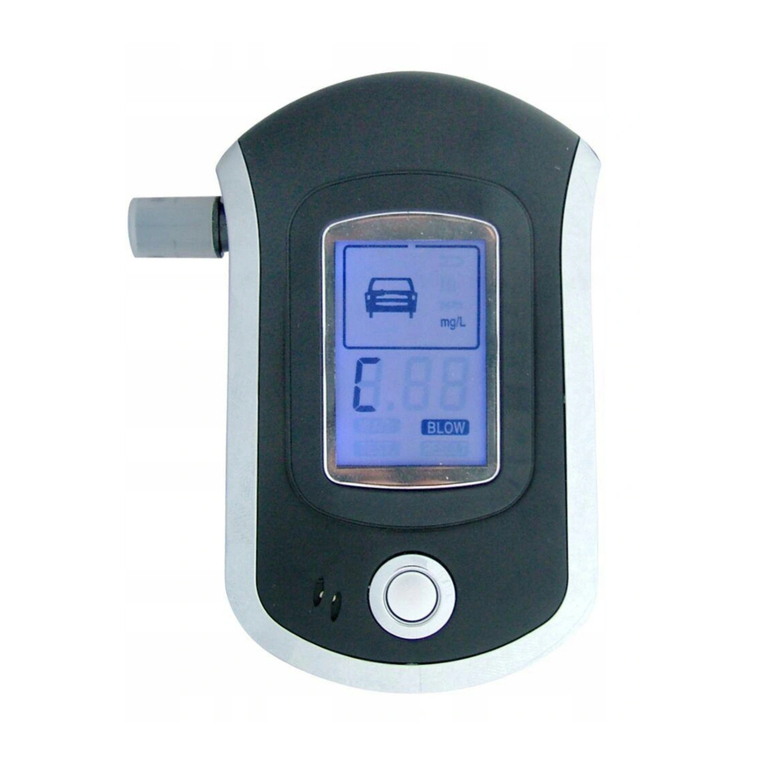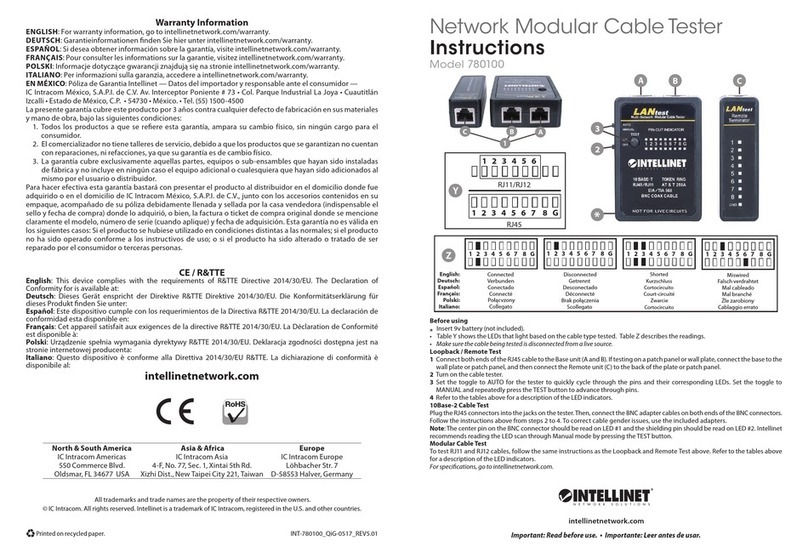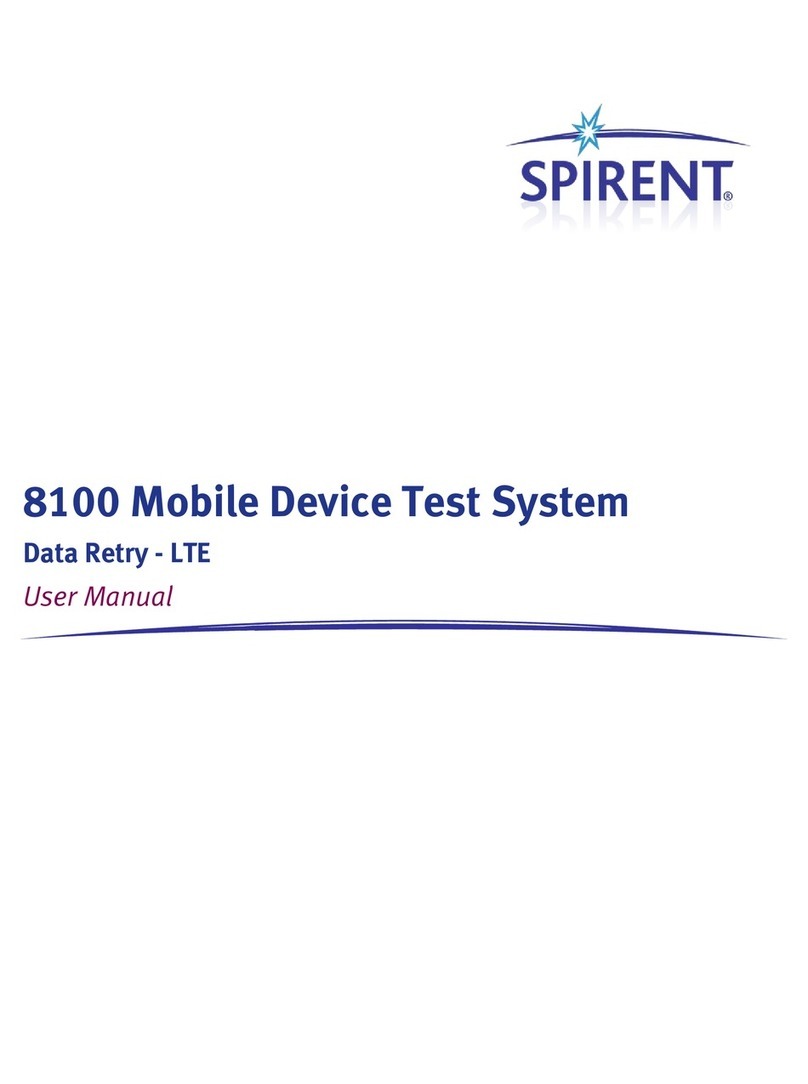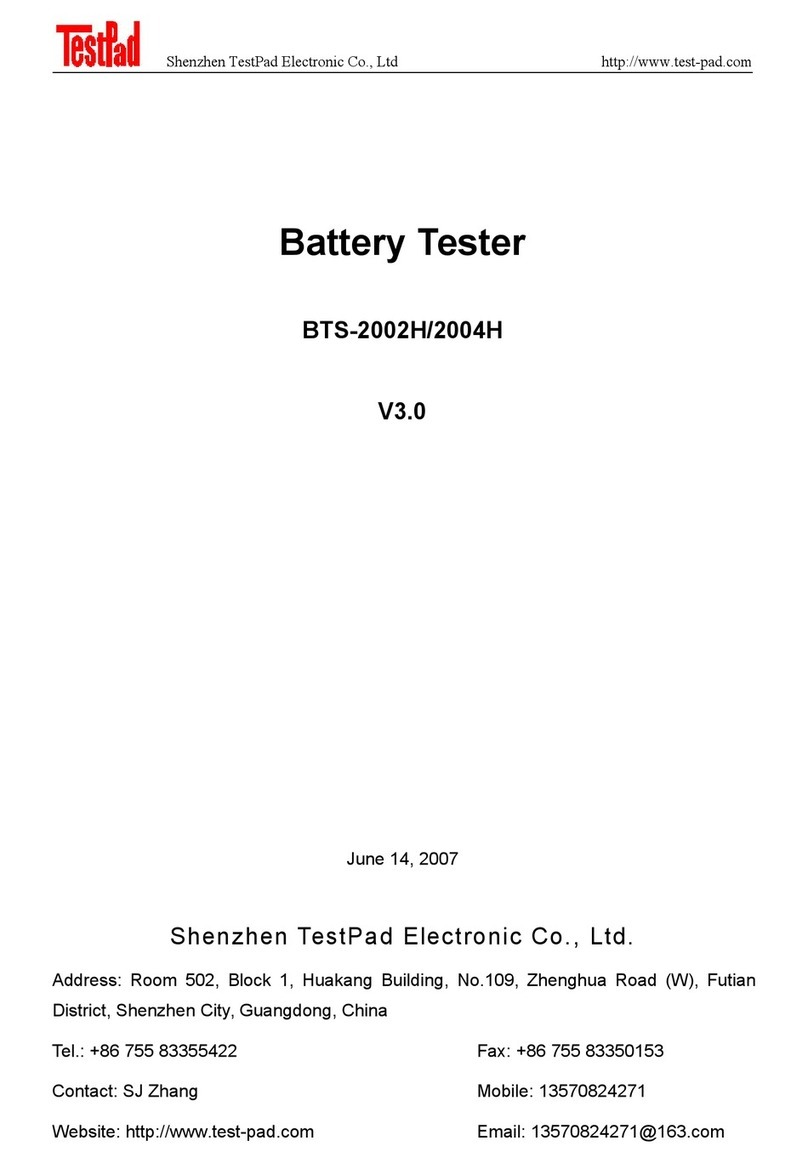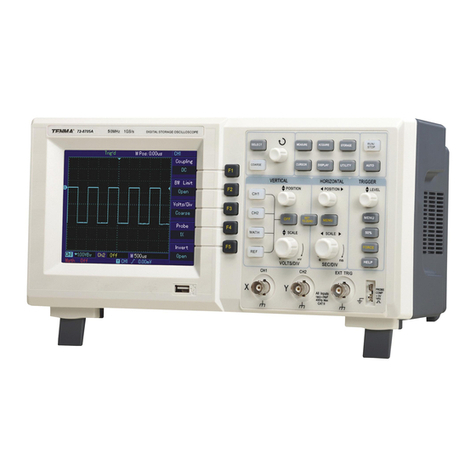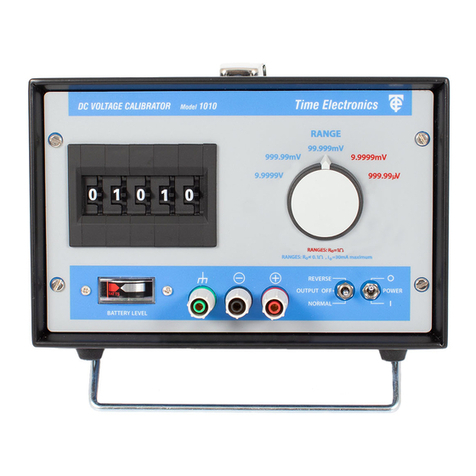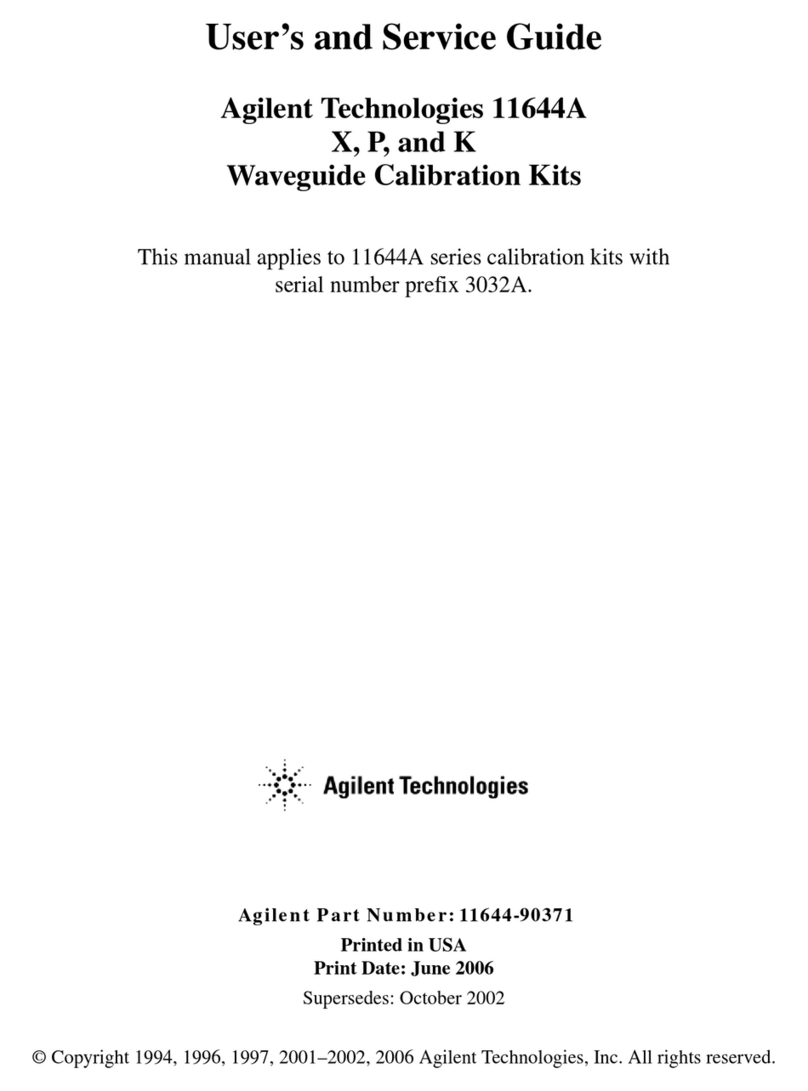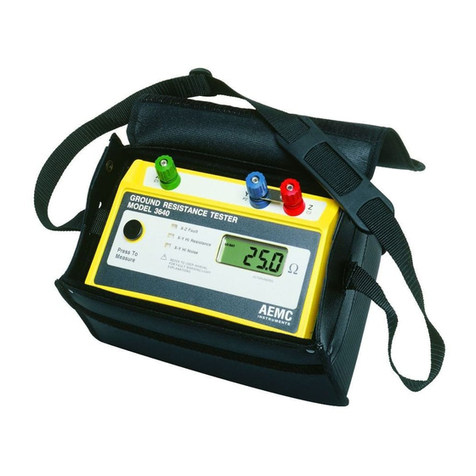Krohn-Hite 523 User manual

Model 523
GPIB Remote Controlled
Precision DC Source/Calibrator
Operating Manual

Service and Warranty
Krohn-Hite Instruments are designed and manufactured in accordance with sound engineering practices and
should give long trouble-free service under normal operating conditions. If our instrument fails to provide
satisfactor service and ou are unable to locate the source of trouble, contact our Service Department at
(508) 580-1660, giving all the information available concerning the failure.
DO NOT return the instrument without our written or verbal authorization. When contacting us, we will
issue a Return Authorization Number that should be referenced on the packing slip and purchase order. In
most cases, we will be able to suppl ou with the information necessar to repair the instrument, avoiding
an transportation problems and costs. When it becomes necessar to return the instrument to the factor ,
kindl pack the instrument carefull and ship it to us prepaid.
All Krohn-Hite products are warranted against defective materials and workmanship. This warrant applies
for a period of one ear from the date of deliver , to the Original Purchaser. An instrument that is found
within the one- ear warrant period not to meet these standards will be repaired or replaced. This warrant
does not appl to fuses or batteries. No other warrant is expressed or implied.
Krohn-Hite Corporation reserves the right to make design changes at an time without incurring an
obligation to incorporate these changes in instruments previousl purchased. Modifications to this
instrument must not be made without the written consent of an authorized emplo ee of Krohn-Hite
Corporation.
CLAIMS
Immediatel upon arrival, purchaser shall check the packing container against the enclosed packing list and
shall, within thirt da s of arrival, give Krohn-Hite notice of shortages or an non-conformit with the terms
of the order.
The purchaser assumes all risk of loss or damage to instrument upon deliver b Krohn-Hite to the carrier. If
an instrument is damaged in transit, purchaser must file all claims for damage with the carrier to obtain
compensation. Upon request b purchaser, Krohn-Hite will submit an estimate of cost to repair shipment
damage.

Model 523 DC Source/Calibrator
_________________________________________________________________________________
[i]
Model 5 3
Precision DC Source/Calibrator
Operating Manual
Revision 4.1. Printed in U.S.A. 10/2013
Model 523Rev4.docx
Cop right 2013
All rights reserved. Contents of this publication ma not be reproduced
in an form without the written permission of Krohn-Hite Corporation.
15 Jonathan Drive, Unit 4, Brockton, MA 02301-5566
Tel: (508) 580-1660; Fax: (508) 583-8989
[email protected]; www.krohn-hite.com

Model 523 DC Source/Calibrator
_________________________________________________________________________________
[ii]
Table of Contents
MODEL 5 3 .................................................................................................................................................................... I
GPIB REMOTE CONTROLLED .................................................................................................................................................... I
PRECISION DC SOURCE/CALIBRATOR ......................................................................................................................................... I
SERVICE AND WARRANTY ............................................................................................................................................. II
CLAIMS ............................................................................................................................................................
II
SAFETY ISSUES .............................................................................................................................................................. V
WARNING ......................................................................................................................................................................... V
POWER SOURCE ............................................................................................................................................................... V
PROPER FUSE.................................................................................................................................................................... V
GROUND THE INSTRUMENT ............................................................................................................................................. V
PROTECTIVE EARTH GROUND .......................................................................................................................................... V
DO NOT OPERATE IN AN EXPLOSIVE AREA ...................................................................................................................... VI
KEEP AWAY FROM LIVE CIRCUITS .................................................................................................................................... VI
DO NOT SUBSTITUTE PARTS OR MODIFY INSTRUMENT .................................................................................................. VI
DO NOT OPERATE A DAMAGED INSTRUMENT ................................................................................................................ VI
DO NOT REMOVE COVER ................................................................................................................................................. VI
UNPACKING AND INSPECTION ........................................................................................................................................ VI
SECTION 1 – GENERAL DESCRIPTION AND SPECIFICATIONS .......................................................................................... 1
1.1
INTRODUCTION ...................................................................................................................................................... 1
1.2
AUTO ZERO OFFSET ................................................................................................................................................ 1
1.3
STORING OUTPUT SETTINGS ................................................................................................................................... 1
1.4
APPLICATIONS ........................................................................................................................................................ 1
1.5
CALIBRATION PROCESS ........................................................................................................................................... 2
1.6
SUPPORT EQUIPMENT NEEDED .............................................................................................................................. 2
1.7
ESTABLISHING TRACEABILITY ................................................................................................................................. 2
1.8
CALIBRATION REPORTS ........................................................................................................................................... 2
1.9
CALIBRATION CHECK ............................................................................................................................................... 2
1.10
CALIBRATION INTERVALS ................................................................................................................................... 2
1.11
TEMPERATURE CONTROL .................................................................................................................................. 2
1.12
SPECIFICATIONS ................................................................................................................................................. 3
1.12.1
Output Specifications (Specifications appl at CAL TEMP ±1ºC, <70% relative humidit .) ......................... 3
1.12.2
GPIB Programming ....................................................................................................................................... 5
1.12.3
Terminals ..................................................................................................................................................... 5
1.12.4
General ........................................................................................................................................................ 5
1.12.5
Safet ........................................................................................................................................................... 5
1.12.6
Electromagnetic Compatabilit ................................................................................................................... 5
1.12.7
Options ........................................................................................................................................................ 5
1.12.8
Optional Accessories .................................................................................................................................... 6
1.12.9
Accessories .................................................................................................................................................. 7
SECTION - OPERATION ............................................................................................................................................... 9
2.1
QUICK START AND TURN-ON PROCEDURE.............................................................................................................. 9
2.1.1
Voltage Selection ......................................................................................................................................... 9
2.1.2
Fuse Installation Instructions ..................................................................................................................... 10
2.2
FRONT PANEL CONTROLS ..................................................................................................................................... 11
2.2.1
Basics Entr Characteristics ....................................................................................................................... 11

Model 523 DC Source/Calibrator
_________________________________________________________________________________
[iii]
2.2.2
Tone Annunciator ...................................................................................................................................... 11
2.2.3
Leading and Trailing Zeros ......................................................................................................................... 11
2.2.4
>15 Volt Indicator ...................................................................................................................................... 12
2.2.5
Shift Ke ..................................................................................................................................................... 12
2.2.6
Remote/Local Ke ...................................................................................................................................... 12
2.2.7
Clear Entr Ke ........................................................................................................................................... 13
2.2.8
Setting the GPIB Address ........................................................................................................................... 13
2.2.9
Crowbar Ke .............................................................................................................................................. 14
2.2.10
Voltage Ke ................................................................................................................................................ 14
2.2.11
Current Ke ................................................................................................................................................ 15
2.2.12
Compliance Limits ...................................................................................................................................... 16
2.2.13
2-Wire/4-Wire Ke (Output Termination) ................................................................................................. 17
2.2.14
Lo To Chassis Ke (flt/chs) ......................................................................................................................... 17
2.2.15
Delta Ke (ENTER ∆ ) .................................................................................................................................. 17
2.2.16
Multipl /Divide Ke (ENTER × ÷) ............................................................................................................... 18
2.2.17
+/– Polarit Ke ......................................................................................................................................... 19
2.2.18
Store/Recall Ke ......................................................................................................................................... 19
2.2.19
Temp Ke ................................................................................................................................................... 20
2.2.20
CAL Ke ...................................................................................................................................................... 20
2.2.21
Clear Mem Ke ........................................................................................................................................... 21
2.2.22
Serial No. ................................................................................................................................................... 21
2.2.23
Digit Select and Controls ........................................................................................................................... 21
2.2.24
Displa Brightness and Contrast Control ................................................................................................... 22
2.3
CONDITIONS THAT WILL PRODUCE AN ERROR MASSAGE .................................................................................... 22
2.3.1
Too High Entr of a Voltage or Current Level ............................................................................................ 22
2.3.2
Too High Entr of a Compliance Voltage Level .......................................................................................... 23
2.3.3
Too High Entr of a Delta Voltage Level .................................................................................................... 23
2.3.4
Output Limit Condition .............................................................................................................................. 23
2.3.5
Storing or Recalling Be ond the Maximum Location of 30. ...................................................................... 23
2.3.6
Recalling from a Location That Has No Stored Setup in It. ........................................................................ 24
2.3.7
Illegal GPIB Address Entr .......................................................................................................................... 24
2.4
OUTPUT CONNECTIONS ....................................................................................................................................... 24
2.4.1
Front and Rear Panel Terminals ................................................................................................................ 24
2.4.2
Wire and Cable Connections ..................................................................................................................... 25
2.4.3
Temperature Control ................................................................................................................................. 26
SECTION 3 - GPIB PROGRAMMING.............................................................................................................................. 7
3.1
INTRODUCTION ............................................................................................................. ERROR! BOOKMARK NOT DEFINED.
3.1.1
Setting the GPIB Address ........................................................................................................................... 28
3.1.2
GPIB Instruction S ntax ............................................................................................................................. 29
3.1.3
Crowbar ..................................................................................................................................................... 29
3.1.4
Voltage ....................................................................................................................................................... 29
3.1.5
Current ....................................................................................................................................................... 30
3.1.6
Compliance ................................................................................................................................................ 30
3.1.7
2 Wire/4 Wire Output Termination ........................................................................................................... 30
3.1.8
Lo Float/Chassis (flt/chs) ........................................................................................................................... 31
3.1.9
Delta ∆ ....................................................................................................................................................... 31
3.1.10
Multipl /Divide ×/÷.................................................................................................................................... 32
3.1.11
+/– Polarit ................................................................................................................................................ 32
3.1.12
Store/Recall ............................................................................................................................................... 33
3.2
TOGGLE ................................................................................................................................................................... 33
3.3
SPECIAL COMMANDS ........................................................................................................................................... 33
3.3.1
Reset Command (*RST or *rst) .................................................................................................................. 34
3.3.2
Calibration Command (*CAL or *cal) ......................................................................................................... 34

Model 523 DC Source/Calibrator
_________________________________________________________________________________
[iv]
3.3.3
Full Calibration Command (523 *CAL or 523*cal) ..................................................................................... 34
3.3.4
Clear Memor Command (*CLM or *clm) ................................................................................................. 34
3.3.5
Identification Quer Command (*IDN? Or *idn?) ..................................................................................... 34
3.3.6
String Quer Command (*STG? or *stg?) .................................................................................................. 35
3.3.7
Last Calibration Date Quer Command (*CLD? or *cld?) .......................................................................... 35
3.3.8
Temperature Quer Command (*TMP? or *tmp?) ................................................................................... 35
3.3.9
Message Quer Command (*MSG? or *msg?) .......................................................................................... 36
3.4
CONDITIONS THAT WILL PRODUCE A SERVICE REQUEST ON THE GPIB ................................................................................. 36
3.4.1
Entr of a Voltage or Current Level Greater Than the Capabilities of the 523 .......................................... 36
3.4.2
Entr of a Compliance Voltage Level Greater than the Capabilities of the 523 ........................................ 36
3.4.3
Entr of too Large a Delta Voltage or Current Value. ................................................................................ 36
3.4.4
Entr of an Unrecognized Instruction or Command. ................................................................................. 36
3.4.5
Output Limit Condition .............................................................................................................................. 37
3.4.6
Storing or Recalling Be ond the Maximum Location of 30........................................................................ 37
3.4.7
Recalling from a Location That Has No Stored Setup ................................................................................ 37
3.4.8
Serial Poll Initial Response B te Chart ....................................................................................................... 37
SECTION 4 - PERFORMANCE VERIFICATION ................................................................................................................ 39
4.1
INTRODUCTION .................................................................................................................................................... 39
4.2
TEMPERATURE CONTROL ..................................................................................................................................... 39
4.3
REQUIRED EQUIPMENT ........................................................................................................................................ 39
4.4
PRELIMINARY SET-UP ........................................................................................................................................... 39
4.5
INSPECTION PROCEDURE...................................................................................................................................... 40
4.5.1
Auto Zero Offset Calibration (AZOC) .......................................................................................................... 40
4.5.2
Output Voltage Checks .............................................................................................................................. 40
4.5.3
Output Current Checks (using PCR100 Precision Resistor) ........................................................................ 41

Model 523 DC Source/Calibrator
_________________________________________________________________________________
[v]
SAFETY ISSUES
WARNING
HIGH VOLTAGE is used in the operation of this instrument. LETHAL voltages ma be present on the output
terminals. Please observe all safet precautions when operating this instrument.
POWER SOURCE
The Model 523 is intended to operate from a 105V to 240V ac rms source. A protective ground connection
b wa of the grounding conductor in the power cord is essential for safe operation.
PROPER FUSE
To avoid damage to the Model 523 or to prevent a fire hazard, use the correct fuse for the line voltage
selected. Proper fuse requirement is screened on the rear panel of the instrument above the power
connector.
The Model 523 has been designed, tested and supplied in a safe condition. The following general safet
precautions must be observed during all phases of operation, service, and repair. Failure to compl with
these precautions or with specific warnings elsewhere in this manual violates safet standards of design,
manufacture and intended use of this instrument. Krohn-Hite assumes no liabilit for the customer’s failure
to compl with these requirements.
This manual contains information and warnings that must be observed to keep the instrument in a safe
condition and ensure safe operation. Operation or service in conditions or in a manner other than specified
could compromise safet . For the correct and safe use of this instrument, operating and service personnel
must follow generall accepted safet procedures.
To avoid injur or fire hazard, do not switch on the instrument if it is damaged or suspected to be fault . Do
not use the instrument in damp, wet, condensing, dust or explosive gas environments.
Whenever it is likel that safet protection has been impaired, make the instrument inoperative and secure
against an unintended operation, and then inform qualified personnel. Safet protection is likel to be
impaired if, for example, the instrument shows visible damage, or fails to operate normall .
GROUND THE INSTRUMENT
To minimize shock hazard, the instrument chassis and cabinet must be connected to an electrical ground.
An interruption of the protective ground conductor inside or outside the instrument is likel to make the
instrument dangerous. Intentional interruption is prohibited.
PROTECTIVE EARTH GROUND
Protective earth s mbols located on the inside rear chassis near the AC line filter module designate the point
at which the safet earth s stem is attached to the chassis. These s mbols must not be altered or removed.
The safet earth wires (green/ ellow) must never be disconnected. The safet earth ground wires
green/ ellow) connecting the module must make direct contact with the chassis.
The following are s mbols used on the chassis of the 523:

Model 523 DC Source/Calibrator
_________________________________________________________________________________
[vi]
---- Chassis Protective Ground
---- AC (Alternating Current)
---- Conforms to European Union Directives
---- Important Information, Refer to the Manual
---- Caution, Risk of Electric Shock
DO NOT OPERATE IN AN EXPLOSIVE AREA
Do not operate the instrument in the presence of flammable gases or fumes. Operation of an electrical
instrument in such an environment constitutes a definite safet hazard.
KEEP AWAY FROM LIVE CIRCUITS
Operating personnel must not remove instrument covers. Qualified maintenance personnel must make
component replacement and internal adjustments. Under certain conditions, dangerous voltages ma exist.
To avoid injuries, alwa s disconnect input voltages before removing the covers.
DO NOT SUBSTITUTE PARTS OR MODIFY INSTRUMENT
Because of the danger of introducing additional hazards, do not install substitute parts or perform an
unauthorized modifications. Return the unit to the Krohn-Hite Service Department to modif or repair the
instrument to ensure that safet features are maintained.
DO NOT OPERATE A DAMAGED INSTRUMENT
Whenever it is possible that the safet protection features built into this instrument have been impaired,
either through ph sical damage, excessive moisture, or an other reason, REMOVE the POWER and do not
use the instrument until safe operation can be verified b service-trained personnel. If necessar , return the
instrument to the Krohn-Hite Service Department for service and repair to ensure that the safet features
are maintained.
DO NOT REMOVE COVER
To avoid personal injur , do not remove the covers of the Model 523. There are no user-serviceable parts
inside the instrument, so there is no reason for an user to remove the covers of this instrument.
UNPACKING AND INSPECTION
The Model 523 has been shipped in a container designed to prevent an damage from occurring during
shipping. Inspect the 523 carefull for damage, and immediatel report an damage to the shipper.
If ou need to return the 523 for an reason, use the original container if possible. If not, ou can order a
new container from Krohn-Hite Corporation at (508) 580-1660 indicating the model and serial number.

Model 523 DC Source/Calibrator
_________________________________________________________________________________
[1]
SECTION 1
General Description and Specifications
1.1 INTRODUCTION
The Krohn-Hite Model 523 Precision DC Source is a highl stable and repeatable dc voltage and current
source providing N.I.S.T. traceable voltages and currents for use in production, calibration labs, QA and QC
departments, design labs, or an place where an accurate voltage or current source is needed.
Using Krohn-Hite’s state-of-the-art reference, the 523 provides accurate and stable voltages to
±110.99999Vdc to within ±4ppm for 90 da s (±8ppm for 1 ear), and precise currents to ±110.99999mA to
within ±8ppm for 90 da s (±16ppm for 1 ear). It is an extremel quiet source with <7μVrms of noise
measured over a 10Hz to 100kHz bandwidth (<2μVrms 0.1Hz to 10Hz).
The 523 features a user friendl 7½ digit displa and a membrane ke board entr for all settings. Output
settings can be modified using a plus/minus delta function, multipl /divide function and cursor control ke s
that allow placing a curse on an digit to increment or decrement its value. Output 2-wire, 4-wire and
chassis grounding are accomplished with one ke stroke. A crowbar function places the output in a safe
mode when desired. The 523 output can be set to 0 volts, allowing the output sense to maintain true 4-wire
low impedance zero output.
1. AUTO ZERO OFFSET
An AUTO ZERO OFFSET CALIBRATION (AZOC) corrects an thermall generated offsets to within specified
limits and is accessible via the front panel or over the GPIB interface bus. The unit is designed for a “Covers-
On Calibration” using the KH523CAL Automatic Testing and Calibration Program (a license is required for
calibration onl ). With the KH523CAL software program and a Model HP3458 or Fluke 8508A Digital
Voltmeter, unattended calibrations can be made in approximatel 15 minutes.
1.3 STORING OUTPUT SETTINGS
The 523 provides for the storage of up to 31 output settings that can be recalled at an time. Internal
operating temperature, serial number, last calibration date and firmware version can all be called to the
displa for quick access when needed. Error messages are displa ed when incorrect or out-of-range entries
are made.
1.4 APPLICATIONS
The Model 523 is well suited for man applications where an extremel accurate and stable dc voltage or dc
current is needed. At a cost much less than most sources in its class, the 523 can be a valuable asset to an
compan ’s production line, calibration lab, QA and QC department and design lab.

Model 523 DC Source/Calibrator
_________________________________________________________________________________
[2]
1.5 CALIBRATION PROCESS
Calibration of the Model 523 requires the HP3458A or Fluke 8508A Digital Multimeter and a precision 100
ohm resistor (optional Krohn-Hite Model PCR100). Calibration constants that define the calibration points
for controlling the output are stored in memor . Traceable calibration to the specified performance is
accomplished in a semi-automated process that updates this table during calibration using the KH523CAL
Automatic Testing and Calibration Program.
1.6 SUPPORT EQUIPMENT NEEDED
The onl support equipment needed for the Model 523 is the HP3458A or Fluke 8508A Digital Multimeter
and a precision 100 ohm resistor (optional Krohn-Hite Model PCR100) for current adjustment checks.
1.7 KROHN-HITE TRACEABILITY
Traceabilit to national standards is accomplished as follows:
Have a traceable to N.I.S.T. (National Institute of Standards and Technologies) HP3458A that is periodicall
checked against an in-house Fluke 732A, 10V Reference. All verifications of calibration must be performed to
better than actual manufacturers specifications.
1.8 CALIBRATION REPORTS
In the future the KHCAL523 Automatic Testing and Calibration Program, provided with each unit, will have
the abilit to displa and print N.I.S.T. traceable reports.
1.9 CALIBRATION CHECK
Checking the calibration of the Model 523 can be simpl accomplished using the KHCAL523 Automatic
Testing and Calibration Program. The program allows for two calibration tests, a voltage onl and current
onl test. The voltage test checks 90 points while the current test checks 46.
1.10 CALIBRATION INTERVALS
The traditional practice of returning a calibrator to a standards laborator at regular intervals for a full
calibration is disruptive, costl and time consuming. It can leave a gap in confidence. You then rel on
manufacturer’s specifications to determine if a calibrator will perform the same outside the lab. So ou then
must assume that drift is predictable enough so that the performance is within limits between re-
calibrations.
However, the Model 523 can be completel calibrated to its original specifications b using a HP3485A
Multimeter, a 100 ohm standard precision resistor and the Krohn-Hite optional KHCAL523 Testing and
Calibration Program, and b not removing its covers or making an adjustment.
1.11 TEMPERATURE CONTROL
To maximize performance in the Model 523, the internal temperatures must be controlled. The 523 has
internal temperature control b the use of a temperature sensor. The 523 can maintain 40°C ±0.1º if
operated in a favorable environment. A favorable environment is one that is maintained between 20°C to
28°C (68°F to 82.4°F) with average temperature changes not occurring faster than 1ºC per hour
(approximatel 2°F per hour).

Model 523 DC Source/Calibrator
_________________________________________________________________________________
[3]
The top cover of the 523 should not be directl exposed to airflow from a heat or air conditioning register,
or air circulating fan. For peak performance when the 523 is moved to a new location, allow the 523 to
acclimate to its environment for 4 to 8 hours. If a room temperature transient should occur, allow 1 to 4
hours for the 523 to correct out the effect. If the 523 has been off for an extended period of time, allow 8
hours for the internal temperatures to stabilize and achieve maximum performance. For short periods, allow
1 to 4 hours. When first making connection to the 523 and other devices, allow temperatures generated
thermals at the terminals to stabilize for a minute or two. This is important for μV level effects.
Following these recommendations will maximize the 523 capabilities and are good practices for an ultra-
precision instrument.
1.1 SPECIFICATIONS
The following specifications are with a constant internal operating temperature equal to Calibration
Temperature (Cal Temp) ±1°C. The HP3458A NPLC is set for 100 and AUTO CAL c cle (ACAL) run. The Model
523’s calibration is normall done at a room temperature of 23°C ±1°C. The internal Cal Temp is saved at the
time of calibration and is displa ed with the present internal temperature using the [TEMP] ke .
The 90 da and 1 ear specifications are valid within 24 hours of a zero CAL (AZOC) c cle, and a constant
internal operating temperature equal to the Calibration Temperature (Cal Temp) ±1°C. The zero CAL (AZOC)
c cle takes out the effect of internal DC offset drift.
1.1 .1 Output Specifications (Specifications apply at CAL TEMP ±1ºC, <70% relative humidity.)
Range Res.
Relative
1
Uncertaint
±1
°
C
Absolute Uncertaint
2
±1
°
C from
calibration temperature
Stabilit
*
±1
°
C
90
da s 1 r 24 hrs 90 da s 1 r 24 hrs
±(ppm output + μV or nA)
DC Voltage
111.11119mV
1.1111119V
11.111119V
110.99999V
10nV
100nV
1μV
10μV
4 + 2
4 + 3
4 + 20
6 + 200
8 + 2
8 + 3
8 + 20
10 +200
3 + 2
3 + 2
3 + 10
5 +100
6 + 2
6 + 3
6 + 20
8 + 200
10 + 2
10 + 3
10 + 20
12 + 200
1 + 1
1 + 1
1 + 10
1 + 100
DC Current
3
11.111119mA
110.99999mA**
1nA
10nA
8 + 40
8 + 200
16 + 40
16 + 200
4 + 20
±24, +400
10 + 40
±30, +400
18 + 40
±38, +400
2 + 20
2 + 100
* Non-Additive
** For values between 12mA and 110mA use graph provided with PCR100 Precision Resistor.
• Note 1: The RELATIVE ACCURACY specifications are to the HP3458A Digital Voltmeter used for
calibration.
• Note 2: The absolute accuracies and traceabilit to N.I.S.T. include the traceabilit accuracies of the
calibration standard and the maintained RELATIVE accuracies of the HP3458A or Fluke 8508A
added to the 523 RELATIVE specifications.
• Note 3: Current calibration uses an external precision 100-ohm resistor (Krohn-Hite Model PCR100) and
measures the voltage using a 4-wire Kelvin connection to the resistor.

Model 523 DC Source/Calibrator
_________________________________________________________________________________
[4]
Range
Temperature Coefficient
Linearit *
±1°C
Noise
Equivalent
Output Z
o
(ohms)
18
°
C
to
28°C
0°C - 18°C
28°C - 40°C
0.1Hz
to
10Hz
10Hz
to
100kHz
±(ppm output + μV or nA)/
°
C p-p rms
DC Voltage
111.1119mV
1.1111119mV
11.111119mV
110.99999V
1 + 0.2
1 + 0.5
1 + 1
2 + 10
2 + 0.2
2 + 0.5
2 + 1
4 + 10
1 + 1
1 + 1
1 + 10
1 + 100
2μV
2μV
4μV
40μV
7μV
7μV
15μV
100μV
0.1μ
1μ
10μ
100μ
DC Current
11.111119
mA
110.99999mA
2 + 5
2 + 10
4 + 5
4 + 10
1 + 20
1 + 100
20nA
200nA
150nA
300nA
10G
1G
Temperature coefficient is best straight line fit method.
* Non
-
Additive
Settling Time: <10ms.
Line Regulation: <±0.1ppm change for a 10% change from normal line voltage, t picall no measurable
change.
Load Regulation 4-Wire Operation: <±0.1ppm change from no load to 100mA full load, t picall no
measurable change. Measurements must be made at sense lead connection point to the load.
Compliance Voltage Effect on Current Output: <10nA change for a 100V change in compliance voltage for
output currents <11.11112mA, equivalent to >10 Gig-ohm output impedance; <100nA change for a 100V
change in compliance voltage for output currents ≥11.11112mA, equivalent to >1 Gig-ohm output
impedance.
Compliance Voltage Limit: Settable in 1V steps from 1V to 110V. Compliance limits approximatel 15%
+0.25V above the setting.
Compliance Voltage Limit: Settable in 1V steps from 1V to 110V. Compliance limits approximatel 15%
+0.25V above the setting.
Maximum Output Current: ±110mA. Output protected from damage with a current limiter. Output ma be
shorted to ground indefinitel .
Warm-Up Time from a Cold Start: 1 Hour to within 5ppm of final value. 4 Hours to rated accurac and final
value.
Calibration: The Model 523 is specified with a 1- ear calibration c cle. An AUTO ZERO OFFSET CALIBRATION
(AZOC) is provided that returns an thermall generated offset to within specified limits, and can be
accessed via front panel controls or over the GPIB interface bus. The Model 523 is designed for a “Covers
On” calibration using the KH523CAL Test and Calibration Software Program. The KH523CAL software,
together with an HP3458A or Fluke 8508A Digital Voltmeter, allows virtuall unattended calibration to be
performed in approximatel 15 minutes. The calibration date and internal temperature is stored in memor
and can be called to the displa or over the GPIB interface bus. Calibration Temperature Limits (“Covers-On
Calibration”): Internal temperature (T Cal), 40°C ±1°C; Ambient temperature (T Amb), 0°C to 30°C.
Isolation: Floated up to 100Vdc with respect chassis ground. Power transformer-to-analog output, control
logic-to-analog output, opticall isolated.

Model 523 DC Source/Calibrator
_________________________________________________________________________________
[5]
1.1 . GPIB Programming
Switching Time: T picall 300ms.
Subsets: SH1, AH1, T6, SR1, RL1, PP1, DC1, DC1, DT1, CO, E1.
Line Termination: The GPIB EOI signal is alwa s sent with the last character on a line.
Talker Function: Allows interrogation of the Model 523 b a controller.
1.1 .3 Terminals
Output Terminals: Gold plated mounted on both the front and rear panels. Onl one set of terminals ma
be used at a time. Both terminal sets are configured for remote sensing of the output as follows:
High Output and High Sense
Low Output and Low Sense
Case Ground.
1.1 .4 General
Display: 2 line, 40 character, backlit, LCD, 7½ digits. Displa s output settings and other pertinent
information.
Keyboard: Membrane. Mechanical
Power Requirements: Selectable 105-130 or 210-240 volts ac, single phase, 50Hz to 60Hz, 60 watts.
Dimensions and Weights: 3.5“ (9cm) high, 14" (36cm) wide, 12.5” (32.13cm) deep; 12 lbs (5.4kg) net, 14 lbs
(6.3kg) shipping.
Operating Temperature Range: 0ºC to 50ºC.
1.1 .5 Safety
The Model 523 is designed to meet the requirements of the following standards of safet for electrical
equipment for measurement, control and laborator use: IEC61010-1, EN61010-1.
1.1 .6 Electromagnetic Compatibility
Emissions and Immunity: EN61326-1, EMC, 61000-4-2; ESD, 61000-4-3; Radiated Immunit , 61000-4-4; EFT,
61000-4-5; Surge, 61000-4-6; Conducted Immunit , 61000-4-8; Magnetic Immunit , 61000-4-11; Voltage
Interruption EN61010-1. CE Compliant for Class B Equipment.
1.1 .7 Options
RK-314: Rack Mount Kit, added brackets for the installation of the Model 523 into 19” rack spacing.
Figure 1.1 – RK-314 Rack Mount Kit
5 3-10: Voltage Limit, limits the output to a predefined value between 17Vdc to 100Vdc.
KH5 3CAL Software Calibration Program: Required to calibrate the Model 523 using an HP3458A or Fluke
8508A and a PCR100 Krohn-Hite Precision 100 Ohm Resistor.

Model 523 DC Source/Calibrator
_________________________________________________________________________________
[6]
1.1 .8 Optional Accessories
CAB005: Cable, 2 conductor shielded balanced line.
Figure 1. – CAB-005 Shielded Balanced Line Cable
CAB018: Cable: multi-stacking double banana plug.
Figure 1.3 – CAB-018 Double Banana Plug Cable
CAB0 3: The CAB023 is a low thermal EMF retractable sheath banana plug patch cord set. These low
thermal cables minimize thermal errors so accurate low voltage measurements can be made. Each set
includes 2 test leads (one black and one red).
Figure 1.4 – CAB-023 Banana Plug Patch Cord
CAB0 4: The CAB024 is a low thermal EMF spade lug patch cord set for low voltage measurements. These
low thermal cables minimize thermal errors so accurate low voltage measurements can be made. Each set
includes 2 test leads (one black and one red).
Figure 1.5 – CAB-024 Spade Lug Patch Cord

Model 523 DC Source/Calibrator
_________________________________________________________________________________
[7]
PCR100: 100 ohm Precision Current Resistor used for calibrating the Model 523 in the Current Mode.
Figure 1.6 – 100 Ohm Precision Resistor, PCR100
Case- 7 0B: Carr ing Case
Figure 1.7 – Model 523 Carr ing Case
1.1 .9 Accessories
3 terminal line cord.
Operating manual.

Model 523 DC Source/Calibrator
_________________________________________________________________________________
[8]
Notes
_______________________________________________________________________________________
_______________________________________________________________________________________
_______________________________________________________________________________________
_______________________________________________________________________________________
_______________________________________________________________________________________
_______________________________________________________________________________________
_______________________________________________________________________________________
_______________________________________________________________________________________
_______________________________________________________________________________________
_______________________________________________________________________________________
_______________________________________________________________________________________
_______________________________________________________________________________________
_______________________________________________________________________________________
_______________________________________________________________________________________
_______________________________________________________________________________________
_______________________________________________________________________________________
_______________________________________________________________________________________
_______________________________________________________________________________________

Model 523 DC Source/Calibrator
_________________________________________________________________________________
[9]
SECTION
OPERATION
.1 QUICK START AND TURN-ON PROCEDURE
The Model 523 will operate at 105, 120, 220 or 240 volts ac line voltages. The following paragraphs explain
how to change the voltage settings and the fuse.
The cover of the Power Module shows four possible voltage settings (105, 120, 220 and 240). A pin will be
located in one of these holes, indicating the present voltage setting for the Model 523. If this setting does
not match the voltage available at our site, then it must be changed before the unit is powered on.
WARNING!
Do NOT power-on the unit if the line voltage setting is incorrect on the Power
Entr Module.
CAUTION!
To avoid shock hazard, connect the factor supplied three conductor line power
cord to a properl grounded power outlet. Do not use a two-conductor adapter
or extension cord. This will break the protective ground connection. Use the
rear panel CHASSIS GROUND terminal for a protective grounding wire if there is
an question about the effectiveness of instrument earth grounding through the
power line cord ground wire.
Figure .1 - Example of 120V Setting
.1.1 Voltage Selection
1. Open cover, using small blade screwdriver or similar tool (see Figure 2.3).
2. Once lifted, the cover will pivot on its hinges, Figure 2.2).
3. Pull voltage selector card straight out of housing, using indicator pin.
4. Orient selector card so that desired voltage is readable at the bottom.

Model 523 DC Source/Calibrator
_________________________________________________________________________________
[10]
5. Orient indicator pin to point up when desired voltage is readable at bottom (note that when indicator
pin is fixed, successive voltages are selected b rotating the card 90° clockwise).
6. Insert voltage selector card into housing, printed side of card facing forward toward IEC connector and
edge containing the desired voltage first.
7. Replace cover, and verif that indicator pin shows the desired voltage.
Figure . – Various Power Module Settings
.1. Fuse Installation Instructions
Make certain the Model 523 power is off and the unit is unplugged from the ac wall outlet.
Insert a pocket screwdriver at point "X" in Figure 2.3.
Figure .3 – Opening Power Entr Module
Gentl lift the entire door UP approximatel 1/4" (minimum). Once lifted, the door will pivot on its hinges to
expose the fuse holder.
Figure .4 – Removing Fuse Holder

Model 523 DC Source/Calibrator
_________________________________________________________________________________
[11]
When the fuse is installed in the single fuse position, appl the screwdriver as shown and gentl lift UP. Use
screwdriver as shown, do not use fingers.
Install one a 3/4A, 120V, slow blow (for 105 to 120V operation) or a 1/2A, 240V, slow blow fuse (for 220 to
240V operation).
Replace fuse holder into housing. Swing and push to snap door back in place.
. FRONT PANEL CONTROLS
. .1 Basics Entry Characteristics
Front Panel features explained on the following pages include all controls, indicators, terminals and displa .
Figure .5 – Model 523 Front Panel
. . Tone Annunciator
The 523 uses tone enunciation to enhance the tactile feedback to the operator. This includes ke tones to
indicate the ke was taken. Other tones are used to indicate a message is presentl in the displa or to
indicate the end of a calibration operation.
. .3 Leading and Trailing Zeros
Leading or trailing zeros are not required to fill out a value. When entering a value that starts with a decimal
point, the 523 will place the leading zero for ou. If a leading zero is entered the 523 will onl allow a
decimal to follow it. If a second zero is entered it is ignored, if a number is entered instead of the decimal it
will replace the zero with the number. Decimal point entr is not required if the value does not require it.
Entering 1 Volt onl requires the entr of the [1] digit then the [VOLT] ke . The 523 will insert the decimal
after the 1 and fill the remaining digits with zeros. 1mV is the same. Depress [1] [MILLI] [VOLT]. The 523 will
enter the decimal and fill zeros after the [MILLI] ke is depressed.

Model 523 DC Source/Calibrator
_________________________________________________________________________________
[12]
. .4 >15 Volt Indicator
If the 523 detects a voltage >15V on the output a >15V LED will light. This LED is located near the output
terminals on the front panel. The detector is independent of all other circuits including the microprocessor.
Figure .6 – Greater Than 15V Indicator
. .5 Shift Key
Ke s with Second Functions are labeled in RED next to the ke . To activate the secondar function of a ke ,
the [SHIFT] ke must be depressed. The Second Function mode will activate and the SHIFT LED will
illuminate. The next ke depressed will now activate the secondar function of that ke . It will also clear the
SHIFT SECOND FUNCTION mode and turn the SHIFT LED off. Depressing the shift ke a second time without
using an other ke will turn the SHIFT mode off. Depressing a ke that has no second function will also clear
the SHIFT mode.
Figure .7 – Shift Ke
There is one exception to clearing the SHIFT mode. It is the second function associated with Displa
Brightness and Contrast using the DIGIT SELECT ke s. This allows the controls to function as a displa control
while the [SHIFT] is engaged. To turn this mode off, the [SHIFT] ke must be depressed again when finished
adjusting the displa .
Ke functions that bring special information to the displa , such as [TEMP], GPIB ADDR or SERIAL NO., will be
brought to the displa for approximatel 5 seconds, then will automaticall return to displa the previous
information.
If the entered value for a function is greater than the 523 capabilities, the 523 operation will not change and
an Error Message will appear in the displa for approximatel 5 seconds, along with the maximum allowed
value for that function. It will then automaticall return to displa the previous information.
. .6 Remote/Local Key
In Remote mode, the 523 will have a partial local lockout. Onl the [REMOTE/LOCAL] ke will be active. No
other ke will function. The REMOTE LED will illuminate indicating it is in Remote mode. To control the 523
from the front panel it must be in Local mode, with the REMOTE LED not illuminated. When in the Remote
mode, depressing the [REMOTE/LOCAL] ke will switch the 523 to Local mode. The [REMOTE/LOCAL] ke
functions as a toggle and can force the 523 into Remote mode thereb disabling Local ke control.
Table of contents
Other Krohn-Hite Test Equipment manuals
